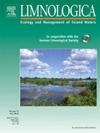土壤颗粒和海拔高度决定了鄱阳湖原核生物群落的分布
IF 2
4区 环境科学与生态学
Q2 LIMNOLOGY
引用次数: 0
摘要
土壤的差异沉积和高程变化是影响湿地生态功能转变的关键因素。本研究旨在探讨土壤颗粒组成和海拔对原核生物群落及相关养分循环的影响。本研究选取鄱阳湖两个不同沉积环境的土壤采集区,沿湿地坡面从低海拔到高海拔采集湿地土壤样品。通过16S rRNA基因测序和土壤酶活性分析,研究了原核生物(古细菌和细菌)群落及其碳、氮、磷代谢相关功能。结果表明,高砂土(砂,55 % ~ 93 %)中古细菌和细菌的Shannon指数以及网络复杂性显著高于高粘土(砂,23 % ~ 42 %)。古细菌和细菌的多样性(ACE和PD_whole_tree)随海拔升高而下降。土壤中碳、磷相关酶活性在富粘土土壤中高于富砂土壤,而氮相关酶活性不受土壤颗粒的影响。与氮、磷不同,所有碳代谢相关酶活性均受海拔的影响。此外,我们发现土壤颗粒通过土壤养分和pH间接影响原核生物群落,而海拔通过土壤湿度和pH间接影响原核生物群落。土壤颗粒对古细菌和细菌群落的影响比海拔更显著。这些发现从微生物的角度加深了我们对土壤颗粒和海拔对湿地生态系统影响的认识。本文章由计算机程序翻译,如有差异,请以英文原文为准。
Soil particles and elevation shape the distribution of prokaryotic communities in Poyang Lake
The differential deposition and elevation changes of soil are crucial factors influencing the transformation of wetland ecological functions. This study aims to investigate the effects of soil particle composition and elevation on prokaryotic communities and associated nutrient cycles. In this study, two distinct soil collection areas with varying sedimentary environments in Poyang Lake, China, were selected, and wetland soil samples were collected along the wetland slope, ranging from low to high altitude. Employing 16S rRNA gene sequencing and analyses of soil enzyme activities, we investigated prokaryotic (archaeal and bacterial) communities and their functions related to carbon, nitrogen, and phosphorus metabolism. The results showed that the Shannon indices of Archaea and Bacteria, as well as network complexity, were significantly greater in high-sand soils (sand, 55 %–93 %) compared to high-clay soils (sand, 23 %–42 %). The diversity (ACE and PD_whole_tree) of Archaea and Bacteria declined with elevation. Carbon and phosphorus-related enzyme activity was higher in clay-rich soils than in sand-rich soils, while nitrogen-related enzyme activity was not affected by soil particles. All carbon metabolism-related enzyme activities were influenced by elevation, unlike nitrogen and phosphorus. Furthermore, we found that soil particles indirectly affect prokaryotic communities by correlating with soil nutrients and pH, while elevation indirectly affects prokaryotic communities by correlating with soil moisture and pH. Soil particles contributed more significantly than elevation to the variation observed in archaeal and bacterial communities. These findings enhance our understanding of the effects of soil particles and elevation on wetland ecosystems from a microbial perspective.
求助全文
通过发布文献求助,成功后即可免费获取论文全文。
去求助
来源期刊

Limnologica
环境科学-湖沼学
CiteScore
3.70
自引率
5.90%
发文量
64
审稿时长
3 months
期刊介绍:
Limnologica is a primary journal for limnologists, aquatic ecologists, freshwater biologists, restoration ecologists and ecotoxicologists working with freshwater habitats.
 求助内容:
求助内容: 应助结果提醒方式:
应助结果提醒方式:


